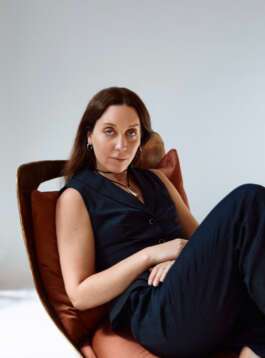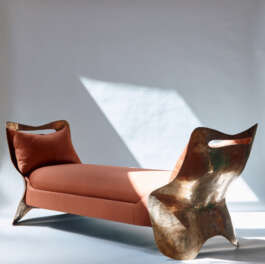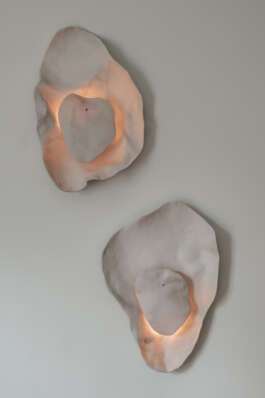



© Mattia De Nardis
COLLECTIBLE In-Depth
Emily Thurman Studio
August 2024
This series, COLLECTIBLE In-Depth, unveils the backstage of contemporary creation. Tackling various topics from personal designer processes to the position of collectible design on the global design market, COLLECTIBLE In-Depth offers different views to suit all tastes. Today we speak with Emily Thurman.
C: What makes design collectible in your eyes?
Emily Thurman: Collectible design is differentiated through the artisan or designer. There is an intent and craft that is unlike mainstream or mass produced design. Often a story is told through the object- a purpose beyond function- that evokes an emotion or unique interaction with the object. Collectible is often artisan made- it is allowing the craft to show through to the finished piece.
C: Can you talk about a new collection that you release for COLLECTIBLE this year?
ET: I release my first collection- “Hundō:. Three years ago when I was in the infancy of starting my studio I intently researched foundry made furniture. And came up with Hundō which is the proto-italic word for “pour out” the origin of “foundry”. Hundō consists of my bronze daybed, bronze ottoman, and translucent porcelain sconces which are all created through the process of molding, pouring and sculpting. The process of creating each of these pieces is an intimate and intuitive approach that required me to be very attentive to the form and feeling I was creating in a piece. After 10 years as an interior designer I can say I am most transformed by this work as it has pushed me beyond design into an artistry I did not know I was capable of.
C: What tips would you give to a collector who wishes to start collecting contemporary design?
ET: You are entering the renaissance of collectible design- there are so many talented designers out there who are eager to have their pieces seen and interacted with. Learn the stories of the pieces you are collecting and choose pieces in which you deeply resonate with. Our homes are not meant to be showrooms- they are meant to be lived in and personal. Find a designer or artisan you connect with and don’t be afraid to ask for a commissioned piece to get something even more personal to you.
C: What has changed the past couple of years in the young scene of collectible design?
ET: I have found that there are more eager young designers entering the scene. I really do mean it when I say we are in a renaissance of collectible design. A lot of ambitious designers are out there funding their own projects and doing everything it takes to get their ideas into physical form and into the world. It’s ambitious and inspiring and I feel so lucky to be a part of this movement. I have also noticed designers have an intent initiative around sustainable design through the usage of responsible materials, attention to ethical labor, and choosing to manufacture locally.
C: What can collectible design bring to the daily lives of the people who collect?
ET: Collectible design much like functional art has a purpose in a collectors life. They most likely interact with these objects on a day to day basis and live with them intimately. These objects have a story of how they were made and why they were made and such as art evokes something within us. This resonance gives a deeper meaning to place.

© Mattia De Nardis

© Kerri Fukui

© Mattia De Nardis
COLLECTIBLE In-Depth
Emily Thurman Studio
August 2024
This series, COLLECTIBLE In-Depth, unveils the backstage of contemporary creation. Tackling various topics from personal designer processes to the position of collectible design on the global design market, COLLECTIBLE In-Depth offers different views to suit all tastes. Today we speak with Emily Thurman.
C: What makes design collectible in your eyes?
Emily Thurman: Collectible design is differentiated through the artisan or designer. There is an intent and craft that is unlike mainstream or mass produced design. Often a story is told through the object- a purpose beyond function- that evokes an emotion or unique interaction with the object. Collectible is often artisan made- it is allowing the craft to show through to the finished piece.
C: Can you talk about a new collection that you release for COLLECTIBLE this year?
ET: I release my first collection- “Hundō:. Three years ago when I was in the infancy of starting my studio I intently researched foundry made furniture. And came up with Hundō which is the proto-italic word for “pour out” the origin of “foundry”. Hundō consists of my bronze daybed, bronze ottoman, and translucent porcelain sconces which are all created through the process of molding, pouring and sculpting. The process of creating each of these pieces is an intimate and intuitive approach that required me to be very attentive to the form and feeling I was creating in a piece. After 10 years as an interior designer I can say I am most transformed by this work as it has pushed me beyond design into an artistry I did not know I was capable of.
C: What tips would you give to a collector who wishes to start collecting contemporary design?
ET: You are entering the renaissance of collectible design- there are so many talented designers out there who are eager to have their pieces seen and interacted with. Learn the stories of the pieces you are collecting and choose pieces in which you deeply resonate with. Our homes are not meant to be showrooms- they are meant to be lived in and personal. Find a designer or artisan you connect with and don’t be afraid to ask for a commissioned piece to get something even more personal to you.
C: What has changed the past couple of years in the young scene of collectible design?
ET: I have found that there are more eager young designers entering the scene. I really do mean it when I say we are in a renaissance of collectible design. A lot of ambitious designers are out there funding their own projects and doing everything it takes to get their ideas into physical form and into the world. It’s ambitious and inspiring and I feel so lucky to be a part of this movement. I have also noticed designers have an intent initiative around sustainable design through the usage of responsible materials, attention to ethical labor, and choosing to manufacture locally.
C: What can collectible design bring to the daily lives of the people who collect?
ET: Collectible design much like functional art has a purpose in a collectors life. They most likely interact with these objects on a day to day basis and live with them intimately. These objects have a story of how they were made and why they were made and such as art evokes something within us. This resonance gives a deeper meaning to place.

© Mattia De Nardis

© Kerri Fukui
Contact
info@collectible.design
VIP PORTAL
EXHIBITOR PORTAL
PRIVACY POLICY
© 2025 Collectible
Contact
info@collectible.design
VIP PORTAL
EXHIBITOR PORTAL
PRIVACY POLICY
© 2025 Collectible